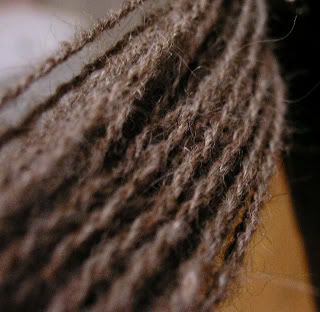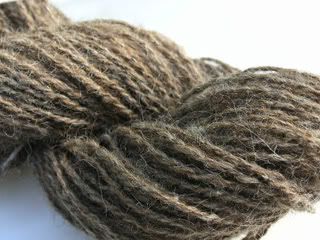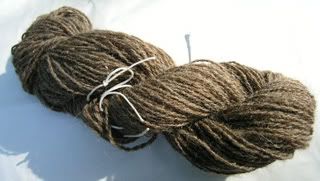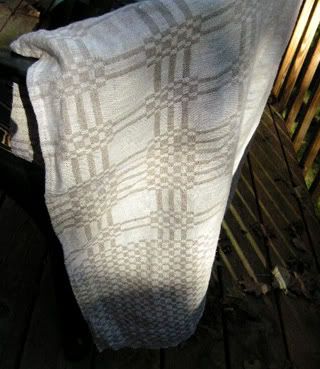Yes, indeedy, practice makes perfect, or nearly so. Look at this!

This could actually be some really rather nice sock yarn! That I made all by myself (and with the help, advice, and instruction of friends!)

I realized after blocking the two hanks of the grey Hampshire/mohair, with which I learned to draft, that I was plying much too loosely. I was trying to ply the way Galina taught us, but (a) I was doing it with much thicker singles and overloading the plying spindle and (b) the cool Orenburg way of plying requires rather more coordination and control than I presently have. So this next time around I instead left the singles in two wound balls, then plied them onto the turnip spindle slowly, checking how twisted each arm-length was before winding it onto the spindle (checking it by holding it loosely and seeing what it did when left to its own devices - nothing so anal as counting twists per inch or anything). Having noticed with the two grey hanks that I had spun and finished first that my overspun singles seemed alright in the finished yarn and that those hanks had seemed much more loosely plied after finishing than before, I deliberately continued to overspin a bit and this time also slightly over-plied these new hanks (of red alpaca/mixed wool - when hanging loosely, they twisted back on themselves just a wee little bit). Then I panicked and ran to Beth to see if I was crazy and whether this had been a bad idea - she reassured me that indeed you lose about 30% of the twist from the singles when you ply, and a bit of the twist from the plying when you finish the yarn. Yay! You always know you're getting somewhere when learning a new skill when you can accurately identify what's going on. This made me feel about 10 times more confident than I'd been moments before reading Beth's email. Phew.
And so the yarn is lovely, and I'm so, so psyched! Now to try the last and final chunk of mixed grab bag roving, and then tackle the merino top Beth gave me. If I can make the latter into a semi-respectable and knittable yarn, I'm going to declare myself Much More Coordinated Than I Thought. And maybe even A Spinner in the Making.

Someday, I want to spin and knit a whole gansey like the Yarn Harlot (thank god Hubbster is not nearly so huge as her Joe, though).
Meanwhile, I had to draw ya'll's attention to a fascinating discussion from the comments on my previous post. I mentioned that it's totally weird of the English language to call flax flax, then change its name to linen after it's spun, while in Russian they sensibly call it the same thing no matter what form it's in - "lyon." Specs, expert in Old English and Norse literature, stepped in on the etymology of "linen":
"I know it shows up in Old English and is probably from an old German(ic) word, but beyond that I'm stuck. Although it is curious -- to me, anyway, it's probably completely wrong-- that the word for "rope, cable, or line" is "line" (pronounced lin-ay). Could be that "linen" comes from that?
Anyway, I couldn't help looking up some other OE words about linen and found some really cool sounding ones:
linenhraegl: linen cloth
linhaewen: flax-colored
linwyrt: flax
linland: "land in flax" (what the heck does that mean?)
(1) I'm TOTALLY using the word "linwyrt" instead of flax from now on: sensible, and entertaining! That's how language should be.
(2) Is "linland" a field full of
(3) Erika, aka historicstitcher, aka an expert on historical textiles, added this note:
old ropes, cables, and lines, at least those used on sailing vessels, were all made from tow, the shorter, rougher flax fibers not used for clothing. Could be that the words derived congruently, coming from the same source, but used differently?
So, it seems, the word linen may have come from some Germanic root and be associated with ropes, lines, hence thread, yarn and cloth. Perhaps it just meant rope/line, but because this was made from flax, the words became associated. Interestingly, the Russian word lyon sounds close enough to maybe derive from the same root, or possibly be a later borrowing from a German(ic) word (Russian has significant borrowings from German, Dutch, French as well as Central Asian languages). So the real question seems to be...where the heck does the word "flax" come from?
You know how English has different words for an animal (e.g., cow) and the food that comes from that animal (beef)? And how usually the coarser word is Germanic(ku, kuh - or is that Norwegian?), while the almost euphemistic word we use when we don't want to think about the animal we're eating is Franco-Latin ("boeuf")? I was always taught that this was because of the waves of influence from different languages, with German(ic) coming first, and therefore being retained in the simpler words. So what if the linen/flax thing is analagous? Except wouldn't it make more sense for flax to be the German word and linen a Franco/Latin thing?
I dunno, but if Specs were to do some more playing with the OED and wherever else she's looking these things up, that'd be cool. (hint, hint)
And I'll leave you with a pic of this beauteous beach towel made from linenhraegl that I bought in Moscow - it's perfect for lying on the beach because it wicks away moisture and stays cool in the sun!


PS - Beth - I need to see that book!!! Greet - thanks for mentioning it!!





















6 comments:
Cause I'm just way too curious for my own good...
A few tidbits from OED:
earliest mention of flax:
c.975, biblical quotation: Flæx. Apparently means the material used in a candle wick, or the wick itself.
Next, also a biblical citation, c. 1000, is for the plant, spelled flex.
Etymologically, you were right with German (to Old English). The debates on roots appear to be between "flah-": "to plait" or "flah-": "to flay," referring to the prepping of the fiber.
Not being a linguist, that's all I've got. Cool discussion though. And awesome spinning. I didn't follow a word of what you were doing, but maybe some day I'll get there.
I'd say you can definitely call yourself a spinner in the making! That's beautiful yarn, there.
The abandoning of the flax agricultural tradition has to do with the mechanization of spinning/weaving. As you might imagine, a long fiber has the potential to really gum up a complicated machine when it goes awry. Before the invention of such machines, cotton was quite expensive, since its very short fibers were difficult to spin. Now, the cheaper linen cloth lengths you see on bolts may well be 'cottonized'(I know, gasp!) - the flax fibers chopped up into cotton-like lengths, so that the mills can spin and weave them. How can you tell? Try to pull a thread from your fabric labeled 'linen'. A cottonized thread will break in just a couple of inches, but linen spun true will yield threads long enough to sew garments with. Which I do regularly, being too lazy to run to the store for matching polyester thread.
And to add to the etymology discussion, I'll quote from the first paragraph in Baines' Intro:
"In 'A Short History of the Linen Trade', the author William Carter reflects 'It is a pity that the German term "flax" [Flachs] found its way into our language in the Anglicised form "flax", because the layman is sometimes confused by the fibre at one stage being flax and later becoming transmuted into something called linen [Lienen].' Flax, then is the term used to denote the plant, the seed and the fibre and linen describes yarn spun from flax fibre, cloth woven from linen yarn and articles made from yarns spun from flax fivers. Once this is understood it is, in fact, clearer to have the two words. In the Latin languages, a single word has derived from Linum to cover all these things (though the French word 'toile' and the Italian 'tela', when used on their own, mean - or used to mean - plain weave, 'tabby' linen cloth).[endquote]
As to lots of peoples having their own words - since flax is an older garment fiber than wool, and wild flax was quite widely distributed (Jared Diamond, 'Guns, Germs & Steel'), I'd expect there to be a lot of variations. (Baines says flax was historically raised from Egypt to northern Europe, albeit at different times.)
Can we tell I'm prepping a lecture on this subject, even if it's 'just' for the SCA? And I want one of those chopper-things, properly called in English, a 'flax-breaker', though only invented in Holland in the 14thc. (Baines again)
Wasn't Galina's spinning class wonderful?? I loved your turnip spindle you picked that day; not only was it fun to watch but it spun like a dream! It looks like you are getting the hang of it. Great yarn! By the way, you picked a great fiber festival as your first. Allegan is a nice one.
Oh wow, there are some excellent responses already here! I didn't look up "flax" last time, but Laura's OED research sounds just perfect.
As for the influx of languages thing, I don't know about flax exactly (and I won't have time to look it up until later today, darn it), but a lot of the french words that entered English are words that are associated with government or high culture. The courts would have been governed by Norman nobility after about 1066, so they brought with them the language they needed to run the place. Thus you see a lot of French in words having to do with legal systems, government, cooking, clothing, and general courtly behaviors.
I am so excited about looking this stuff up later! I just wish we'd had this discussion a few months ago when I'd had access to a library instead of just my inadequate collection of books.
I was taught that the cow/beef, pig/pork thing was due to class separation - the servant class which raised the animals used the Germanic words, the society class only really saw these animals on the plate and spoke French.
Post a Comment